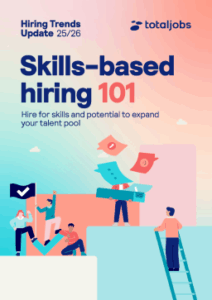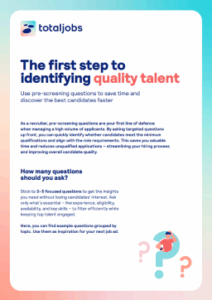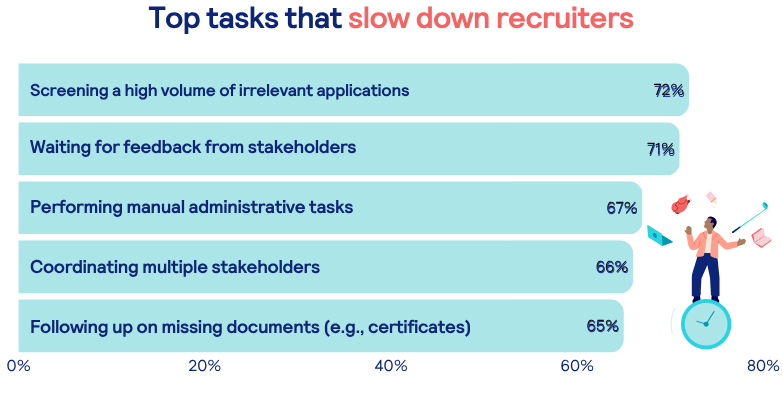
What’s slowing down your hiring? UK survey reveals the top blockers and breakthroughs
Table of Contents
- Screening CVs takes 3.6 hours per vacancy
- Manual tasks take over two workdays
- AI is helping recruiters improve efficiency
- Too many interview stages slows down hiring
- Why candidates dropped off from the hiring process

Skills Based Hiring Template
With the speed at which the jobs market evolves, recruiters often feel pressured to fill roles quickly. Yet when they receive hundreds of applications, weeding out top talent takes time.
We found that 72% of recruiters say screening many irrelevant applications is slowing down the hiring process. Recruiters also spend over 2 days per vacancy on manual tasks, costing businesses £16.7K per year*.
Our latest research dives into the ins and outs of hiring, uncovering the inefficiencies slowing down recruiters and causing candidates to drop off.
In this article, we’ll share tips to cut hiring time and increase efficiency in the hiring process.
Get started by downloading our pre-screening questions to help you identify top talent quickly.

Pre-Screening Questions Template
*Disclaimer: Manual tasks take 17.7 hours per vacancy, assuming 4 hires are made per month, this comes up to 849.6 hours/year. Costing 849.6 × £19,69/hour (Avg. recruiter salary 36,7k p.a.) = £16,728.62. Note: This is only an indicator of hidden costs in everyday recruiting and not an exact cost analysis.
Recruiters spend 3.6 hours per vacancy screening CVs

According to our research, recruiters are tasked with hiring for 4 roles each month and receive 20 applications per role.
It takes 3.6 hours per vacancy to filter out irrelevant applications and find the best candidates to move forward with.
As screening applications is a manual task for most, 72% of recruiters say it’s one of the top causes of a slow hiring process.

Better application quality and relevancy means less time spent on screening. Use structured pre-screening questions and matching logic to filter out irrelevant applications, especially for high-volume roles.

Make sure your job ads are clear and share salary and benefit information, if your company policy allows, to set expectations from the start.
Looking at the top tasks that slow down recruiters, we can divide tasks into two categories: manual tasks and managing stakeholders.

Manual tasks cost recruiters over two days’ worth of work per vacancy
While recruiters spend valuable time aligning with stakeholders on their requirements and feedback after interviews, manual work such as scheduling, entering post-interview notes and data entry is taking up too much time.
Stakeholder management, Time spent per vacancy (hours)
- Intake meeting with stakeholders, 2.8h
- Aligning internal feedback, 3.1h
- Follow-up and decision making with hiring managers, 3.1h
Manual tasks, Time spent per vacancy (hours)
- Reviewing applications, 3.6h
- Writing and publishing job ads, 2.8h
- Data entry and documentation in HR systems, 3.1h
- Post-interview processing (notes, updating profiles), 3h
- Providing candidate feedback and rejections, 2.7h
- Scheduling interviews, 2.5
Scheduling becomes quite a big factor at times… you might want to book an interview for next week and suddenly they’re no longer available for another two weeks, so you push the process back.
The average time spent on manual tasks per vacancy is 17.7 hours or over two working days. Considering 4 hires are made per month, that’s £16.7K per year per recruiter on an average recruiters’ salary.
So, half of recruiters say manual tasks take too much time. That time can be spent on crucial candidate engagement and sourcing activities.
Especially as out of the 28% of candidates who have dropped out of the hiring process, 1 in 4 (23%) said the communication was unclear or slow.

Automate documentation, feedback input, and scheduling support to reduce the manual workload post-interview – areas often cited as time drains.
After the interview finishes, the note-taking part and then needing to input all those notes into their profile… takes a lot of work.
Most recruiters are using AI to improve hiring efficiency
Positively, 77% of recruiters are using AI in some capacity to improve hiring efficiency.
AI is already cutting hiring time when it comes to creating job ads, reviewing applications and data entry.
Recruiters that use AI can spend more time on vetting candidates, engaging with them through the process, sourcing candidates, and aligning with stakeholders.

The remaining 23% who don’t use AI give the below reasons:
- I’m not familiar with what AI tools are available (37%)
- I believe human judgement is better than AI (35%)
- I don’t trust AI to make accurate or fair decisions (24%)
- Our current systems don’t support AI integration (23%)
Considering concerns about bias and legal limitations, AI use must be always balanced with human decision-making.

AI can save up ample time where it works best – in completing manual hiring tasks with human oversight (such as writing job descriptions, taking interview notes, summarising feedback, personalising communications with candidates).
36% of recruiters say their company has too many interview stages
According to recruiters, interviews are another time-drain in the hiring process.
- 34% of SMEs and large businesses say lengthy interviews slow down hiring
- 1 in 3 (32%) large businesses and 1 in 4 SMEs say too many interview rounds are wasting time
- Recruiters in SMEs recommend 2 rounds max, with this number going up to 3 for large businesses
Recruiters are also hampered by manual tasks after interviews (23%), poor availability of stakeholders (24% for large businesses, 18% for SMEs), no clearly defined processes (20%) and gathering feedback from hiring managers (22% for large businesses).

Reduce interview rounds, standardise formats, and limit touchpoints to accelerate hiring while maintaining candidate engagement and quality.
Why candidates dropped off from the hiring process
When the hiring process takes too long and there is miscommunication or misaligned expectations along the way, it causes candidates to drop off. This worsens inefficiency as qualified candidates are lost even at the final stages of hiring.

Top reasons candidates dropped off
The role didn’t meet my expectations (30%)
- I received a better offer (28%)
- The process took too long (25%)
- Communication was unclear or slow (23%)
- The role expectations weren’t clearly defined (21%)
A clear job description and establishing expectations in the first screening call can remove any question marks and engage candidates. While keeping candidates in the loop and a quick hiring process retains them.
When asked what would keep them in the process, candidates said; more transparency about the role requirements (39%), more transparency about salary (35%), clear expectations for the hiring process (34%), faster feedback (34%) and a shorter overall process (30%).
77% of candidates also say application status trackers would be beneficial.

Set up clear response timelines and automated follow-ups within ATS platforms to support tighter feedback loops to mitigate delays as candidates may drop off due to lengthy processes and delays in communication.
About the study
We asked 748 HR leaders and 2,025 jobseekers in the UK where they struggled to remain efficient in the hiring process.
The recruiter survey and the jobseeker survey were both done online between 25th of June and 3rd of July 2025.
The jobseeker survey is representative of the UK population by gender and age.
Receive the latest recruitment resources and
advice to boost your hiring
By providing us with your details you agree to our privacy policy and for us to keep you updated with the latest news, events,
and special offers from Totaljobs.






